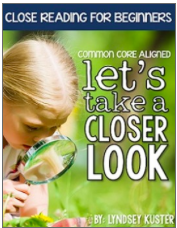My type tends to be nonfiction ...
Is this because of the population I am teaching?
Is this because of my interest?
Is this because of student interest, especially during the early elementary ages?
Is it really easier to use nonfiction?
"Much research has been done on why and how students can best comprehend a text, but less has been said about what kinds of text can best aid the development of comprehension skills" according to Carol Einstein, in Activating Comprehension (EPS).
Nonfiction text allows for quick and easy instruction with "RIGHT THERE" kinds of questions. You know, those kinds of questions that have direct answers that are right there in the text. This is a common first step when teaching comprehension.
Nonfiction has many features - those great TEXT FEATURES that we emphasize. Have you heard yourself saying ...
"these extra features contain information ..."
"read the text features, too..."
"Did you survey the WHOLE page?"
"What extra information does the page give you?"
Questions that guide comprehension are often linked to text features. Students are instructed to use all of the juicy details from these features to better understand the story. This, again, is an early, and fairly explicit way to teach comprehension.
Nonfiction texts are usually high interest for young readers. Animals, insects, weather, natural disasters, space, cars, sports - you see what I'm getting at. Interest in the text makes comprehension much easier AND students will willingly reread, practicing close reading strategies. Rereading is, of course, a cornerstone to deeper understanding and comprehension instruction.
Nonfiction also allows for meaningful connections. Many times, students may come with prior knowledge or a partial understanding for nonfiction topics. Think about weather ... students usually have some knowledge of sun, rain, snow, etc, - this allows comprehension to be easier. Students can think back to what they know or have experienced. This is a wonderful asset to teaching comprehension.
AND, if prior knowledge is not there, nonfiction topics allow teachers to build that schema with field trips, videos, photographs, artifacts, games, activities, music and much more.
So ... is nonfiction text an easier choice for teaching beginning comprehension skills?
What's your thought?
Some great nonfiction resources I use:
Close Reading Informational Text



choosing right class is very important due to the fact that wrong classes will cause eternal suffering in college\university and will make you to ask someone to do your homework for you
ReplyDeleteThank you. This post was useful for me. And I think all who visit this site, find they seek. But, generally, I use college essay writing service reviews. Maybe it will help someone.
ReplyDeleteThanks for sharing this blog. This very important and informative blog
ReplyDeleteLearned a lot of new things from your post! Good creation and HATS OFF to the creativity of your mind.
Very interesting and useful blog!
best Java training in Gurgaon